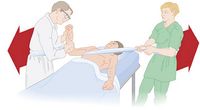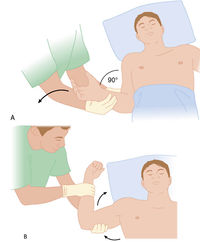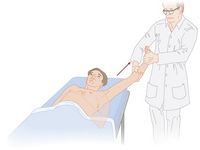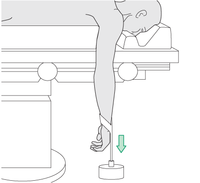Anterior shoulder dislocation
Revision as of 04:29, 18 February 2015 by Rossdonaldson1 (talk | contribs) (Created page with "==Background== *>99% are anterior dislocation assoc w/ indirect blow *Must rule-out axillary nerve injury *Consider intra-articular lidocaine (10-20mL) as alternative to proce...")
Background
- >99% are anterior dislocation assoc w/ indirect blow
- Must rule-out axillary nerve injury
- Consider intra-articular lidocaine (10-20mL) as alternative to procedural sedation
Clinical Features
- Arm held in abduction w/ shoulder lacking normal rounded contour
- Difficulty (painful) touching ipsilateral arm to contralateral shoulder
Diagnosis
Imaging
- Prereduction radiographs advised for traumatic mechanism (rule-out fx-dislocation)
- AP
- Will show dislocation
- Scapular lateral or "Y"
- Will show whether dislocation is anterior or posterior
Differential Diagnosis
Management
- Reduce (see techniques below)
- Post-reduction: sling w/ shoulder in adduction/internal rotation
- Ortho referral for 1st-time dislocation
Reduction Techniques
- Traction-Countertraction
- External Rotation (Kocher)
- Milch
- Stimson
- Place pt prone on edge of table.
- If pt sedated or intoxicated, secure pt to stretcher with belts or sheets
- Shoulder is placed over floor while the pt is prone so that the arm can fall 90 degrees to pt and floor.
- Attach a 5-kg weight to the arm, and the patient maintains this position for 20–30 min, if necessary.
- Occasionally, gentle external and internal rotation of the shoulder with manual traction aids reduction.
- Consider combining with scapular manipulation (The inferior tip of the scapula is pushed medially and dorsally with the thumbs while the superior aspect of the scapula is stabilized with the fingers of the superior hand)
- FARES (Fast, Reliable, and Safe) Method: No sedation required!
- Apply traction while holding wrist to the affected limb in a neutral position beside on a supine patient
- Oscillate limp up and down (anteriorly/posteriorly) while continuing to apply traction and start slowly abducting the limb.
- Once abducted to 90 degrees, externally rotate and continue with ongoing traction and oscillations past this position. Reduction is usually achieved once abducted to 120 degrees.
- Cunningham Technique: [1]
- No sedation required although analgesia still administered
- Massage the bicipital muscle in the mid humerus
- Maintain the the patient's affected arm adducted, and the elbow flexed, massaging the biceps
- At the same time the patient is told to move the shoulder superiorly (up), and posteriorly (back) to allow the humeral head to relocate back into the glenoid fossae.[2]
Complications
- Recurrent dislocation (>90% in age <20yr)
- Bony injuries:
- Usually do not affect management
- Hill-Sachs lesion (compression fracture of humeral head) - occur in up to 40% of cases; more likely with recurrent anterior dislocations
- Bankart lesion (injury to inferior glenoid labrum) - occurs in 10-20% of cases
- Usually do not affect management
- Axillary nerve - occurs in up to 14% of cases; usually transient deficits
- Axillary artery - rare
- Rotator cuff tear
Disposition
- After reduction, may discharge
References
- ↑ http://www.youtube.com/watch?v=MkdCGV_MOCM
- ↑ Neil Cunningham, MBBS, FACEM. "Cunningham Technique". Shoulderdislocation.net.






